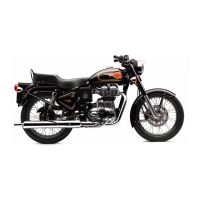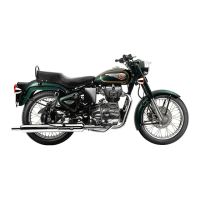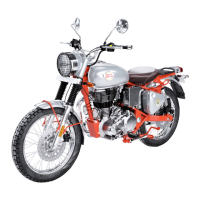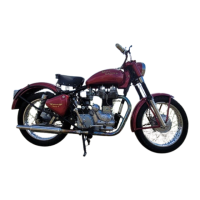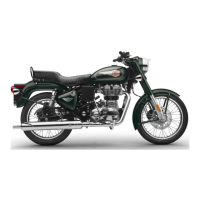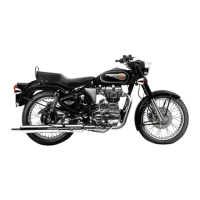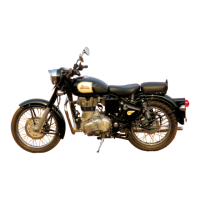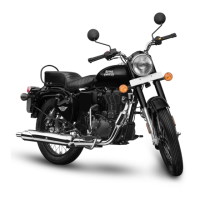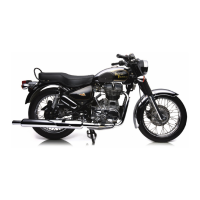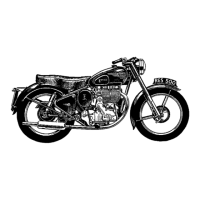
Do you have a question about the Royal Enfield Bullet RES 500 and is the answer not in the manual?
| Displacement | 499cc |
|---|---|
| Seat Height | 800 mm |
| Bore x Stroke | 84mm x 90mm |
| Compression Ratio | 8.5:1 |
| Clutch | Wet multi-plate |
| Frame Type | Single Downtube, Using Engine as Stressed Member |
| Ground Clearance | 135 mm |
| Transmission | 5-speed constant mesh |
| Fuel Tank Capacity | 13.5 liters |
| Front Brake | 280mm disc |
| Rear Brake | 153mm drum |
| Ignition System | Electronic ignition |
| Front Suspension | Telescopic forks |
| Rear Suspension | Twin shock absorbers |
Explains the origin and purpose of the manual, detailing the author's experience with Royal Enfield motorcycles.
Defines horsepower and torque in the context of motorcycle engines, explaining their relevance to performance.
Provides a step-by-step guide for starting the motorcycle, including details on the kickstarter and decompression lever.
Offers guidance on diagnosing and resolving issues related to starting the engine, covering common problems.
Details essential lubrication points and procedures for the motorcycle, including oil levels and cable lubrication.
Explains how to adjust the clutch linkage for proper operation, covering pushrod end play and cable adjustment.
Covers adjustments for both front and rear brakes, including pedal free play and cable tension for optimal performance.
Details the process of adjusting the carburetor, including jetting, pilot jet, and main jet settings for optimal mixture.
Explains how to check and set the ignition timing, covering signs of incorrect timing and point gap adjustment.
Provides instructions for removing and replacing the front wheel, including details on brake cable and axle removal.
Guides the user through the process of removing and replacing the rear wheel, differentiating between QD and standard types.
Offers advice and steps for changing motorcycle tires, emphasizing the importance of proper technique and tools.
Details the procedure for replacing throttle and clutch cables, including inspection and removal steps.
Explains the function and replacement of the quill-style oil pressure feed bush, a unique feature of the Bullet.
Covers the process of removing the cylinder head for inspection and cleaning, including valve assembly details.
Details the removal of the cylinder barrel, including piston and ring inspection, and cylinder bore wear assessment.
Describes the components and operation of the front forks, including damping mechanisms and adjustments.
Covers attention needed for the swingarm rear suspension, focusing on shock units and swingarm bushes.
Explains the function of the clutch within the primary chaincase and outlines servicing procedures.
Details how to check and adjust the neutral finder mechanism for proper gear selection.
Addresses common gear changing problems, including faulty detent plunger action and misadjusted shifter plates.
Explains the kickstart pawl mechanism and identifies potential causes and solutions for slipping or intermittent action.
Diagnoses issues leading to incomplete gear engagement, such as restricted shifter movement or worn components.
Outlines the general procedure for dismantling the gearbox, starting with the outer cover.
Provides instructions for removing the outer gearbox cover to access internal components.
Details the process of stripping the gearbox, including removal of the entire gearset and related components.
Guides the inspection of gearbox components like gears, dogs, shafts, bushings, and bearings for wear or damage.
Explains the ball-and-ramp clutch throwout mechanism and its adjustment procedure.
Provides a description of the 5-speed gearbox, highlighting its differences from the 4-speed version.
Details troubleshooting steps for incomplete gear engagement issues within the 5-speed gearbox.
Covers the reassembly of the outer cover, including fitting the O-ring and securing the case.
Provides steps for assembling the layshaft with gears and washers, referencing part numbers.
Explains the assembly of the shifter mechanism, including the rocker shaft and shifter shaft components.
Details the VM24 Mikcarb carburetor, an Indian-made version of the Mikuni, and its important parts.
Describes the VM28 Mikcarb carburetor, noting its interchangeability with some Mikuni models.
Covers the Amal Monobloc carburetor, produced in the mid-50s to mid-60s, and its starting mixture enrichment.
Explains the Amal Concentric carburetor and its starting mixture enrichment method via the float 'tickler'.
Guides on achieving the optimum fuel-air mixture through plug checks and needle position adjustments.
Provides fundamental principles of electricity and troubleshooting techniques for electrical systems.
Lists essential tools and materials required for electrical troubleshooting and repair.
Details the electrical system for North American export models, focusing on wiring diagrams.
Presents the wiring diagram specific to the Home (Indian) model of the motorcycle.
Offers a strategy for troubleshooting by isolating individual components and conductors in the electrical system.
Explains how to interpret switch connections and trace power flow through the electrical system.
Provides a practical example of troubleshooting an ignition system failure using a test lamp.
Details the various switches and their connections, including alternator and rectifier/regulator information.
Outlines the differences in electrical systems for North American, UK, and Home models.
Presents the specific ignition and main switch connections for UK models.
Discusses general principles of engine tuning for higher performance, emphasizing optimization of existing systems.
Explains improvements to volumetric efficiency through modifications to intake, exhaust, and cam timing.
Covers improvements to thermal efficiency, focusing on compression ratio and fuel quality.
Describes the Pulse Air Valve System used on later US-Export Bullets for emissions control.
Explains the function of the crankcase breather condenser tank and its maintenance.
Provides a comprehensive list of engine fasteners and their specified torque values in various units.
Lists critical service limits and clearances for various engine and chassis components.
Offers a conversion table for inch and metric measurements, useful for specifications and adjustments.
Provides detailed technical specifications for the 500cc Royal Enfield Bullet model.
Provides detailed technical specifications for the 350cc Royal Enfield Bullet model.
Offers methods for identifying the year and month of manufacture for Royal Enfield motorcycles.
A summary table of common motorcycle symptoms, their possible causes, corrections, and corresponding page references.
